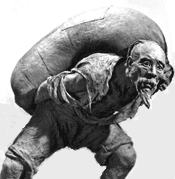










|
|

|
Background and History
In June 1965, a group of sculptors from the Sichuan Institute
of Fine Arts was assigned by the provincial leadership to
create a panaroma of 114 life-size clay figures depicting
peasants bringing their rent into a notorious landlord’s
residence, his “brutal exploitation” of the
peasants, and their “simmering anger.” The theme,
expounding class struggle, coming from the people, and set in
pre-Liberation days, is highly political and educational and
parallels those of the model operas.
|
The Rent Collection Courtyard was produced and installed in the open
verandas of a landlord's old mansion, which had been converted into
a museum.
To increase its potential impact as a "model," as well as
to spread its educational message, the Rent Collection Courtyard was
quickly publicized and just like the operas, it underwent revisions.
Replicas were put on display in Beijing and modifications were
introduced. The 114 figures were increased to 119, some were
remodeled, incorporating the ideas of workers, peasants, soldiers,
and Red Guards. These revisions gave "bolder expression"
to the "great and invincible thought of Mao tse-tung." The
most extensive changes were in the final section of the six-part
display, the portion titled “Revolt.” Here scuptured figures held placards with political
slogans or a volume of Mao’s writings. The revised version was
touted as a victory for Mao Zedong Thought.
From Ellen Liang, The Winking Owl
(Berkeley:
University of California Press, 1988), p. 62.
The Six Parts of the Rent Collection Courtyard:
Bringing the Rent
|
Examining the Rent
|
Measuring the Grain
|
Reckoning the Accounts
|
Forcing the Payment
|
Revolt
Related Readings
Rent Collection Courtyard - Sculptures of Oppression and
Revolt
(Beijing: Foreign Languages Press, 1968)
—Forward and Introduction
—Comments by workers, peasants, soldiers, and foreign observers
—Scene by scene notes
We Must Revolutionize Our Thinking and Then Revolutionize
Sculpture
—
An article by the artists who created the Rent Collection Courtyard
sculptures,
Chinese Literature (No. 4, 1967)
Appraisals of 'Compound Where Rent Was Collected'— A collection of writings by workers, peasants, soldiers,
and Red Guards about the Rent Collection Courtyard,
Chinese Literature (No. 4, 1967)
The Rent Collection Courtyard Revisited:
Cultural Revolution, Chapter 2; Expatriate Artist Updates Maoist
Icon and Angers Old Guard, The New York Times, August 17, 2000: At the 1999 Venice
Biennale, artist Cai Guo-Qiang's partial reconstruction of the Rent
Collection Courtyard generated controversy and debate.
|